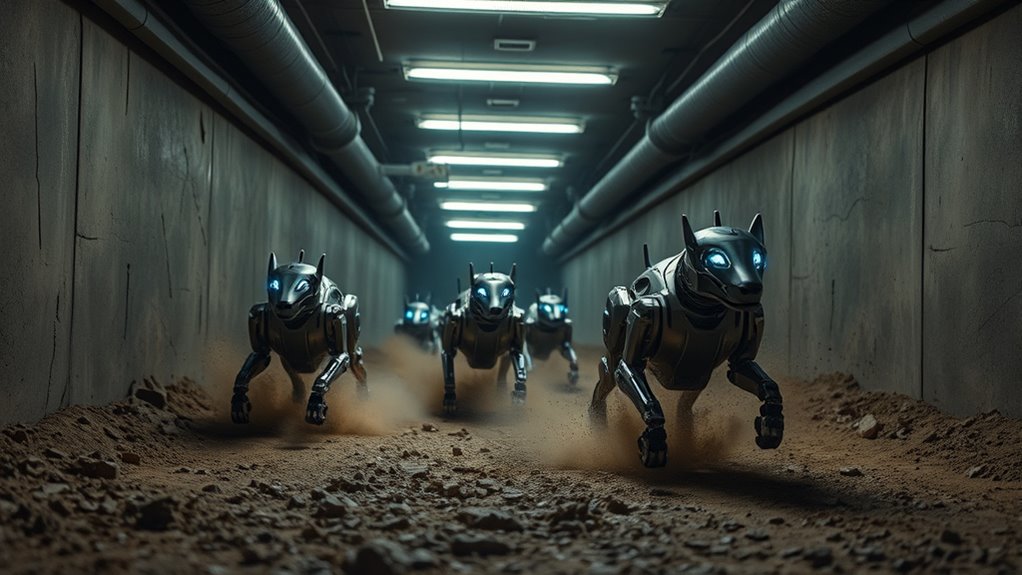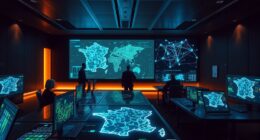In recent US-South Korea military drills, robot dogs played a vital role in tunnel warfare training against North Korea’s underground networks. These advanced machines helped minimize risks for soldiers by performing intelligence-gathering tasks and carrying explosives in confined spaces. More than 370 soldiers practiced key strategies, enhancing their capabilities in battling this unique threat. These exercises illustrate how robotics are becoming integral to modern warfare. To understand how this impacts future operations, keep exploring the details.
Key Takeaways
- Robot dogs were utilized in drills to minimize risks for soldiers during operations in North Korea’s extensive underground tunnel networks.
- The drills aimed to enhance joint capabilities of U.S. and South Korean forces in countering North Korea’s military infrastructure.
- Robot dogs are equipped for intelligence gathering and can carry explosives for strategic deployment in confined environments.
- Training facilities simulated realistic underground conditions, providing soldiers with essential experience in tunnel warfare tactics.
- The integration of robotics, including robot dogs, reflects modern military strategies focusing on operational efficiency and safety in combat scenarios.
Location and Context of the Drills
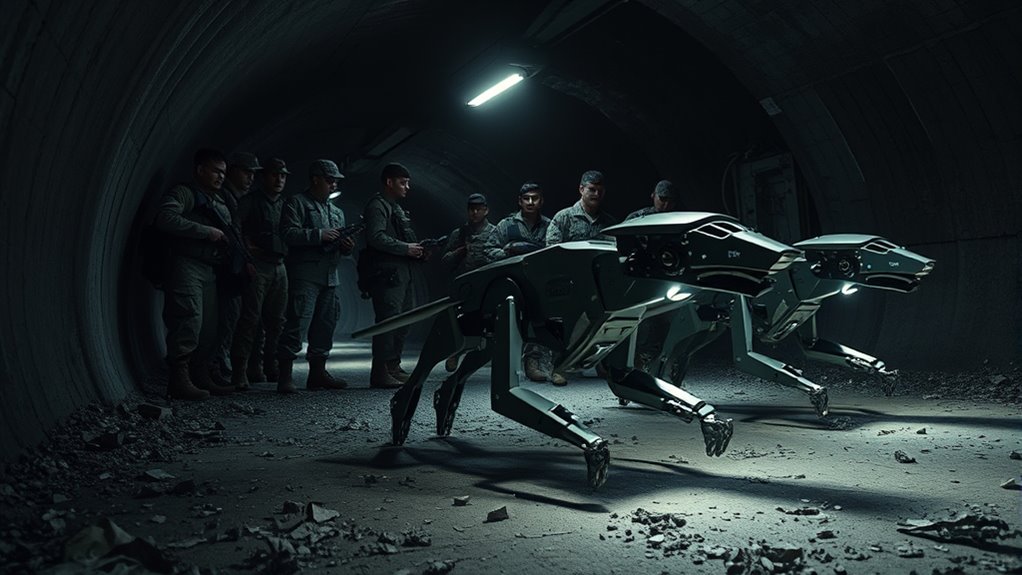
While the drills took place in Paju, Gyeonggi Province, near the North Korean border, their significance goes beyond just location.
You’ll find that Paju’s strategic position makes it ideal for realistic training scenarios, especially for storming North Korea’s extensive underground tunnel network. This area offers the perfect terrain to practice essential tactics, enhancing the readiness of South Korean and U.S. forces against North Korean threats.
The drills are part of the Freedom Shield exercises, aimed at countering North Korea’s military capabilities. They also incorporate lessons from recent conflicts, ensuring that both forces are prepared for potential subterranean warfare.
Technology Employed in Tunnel Warfare Training
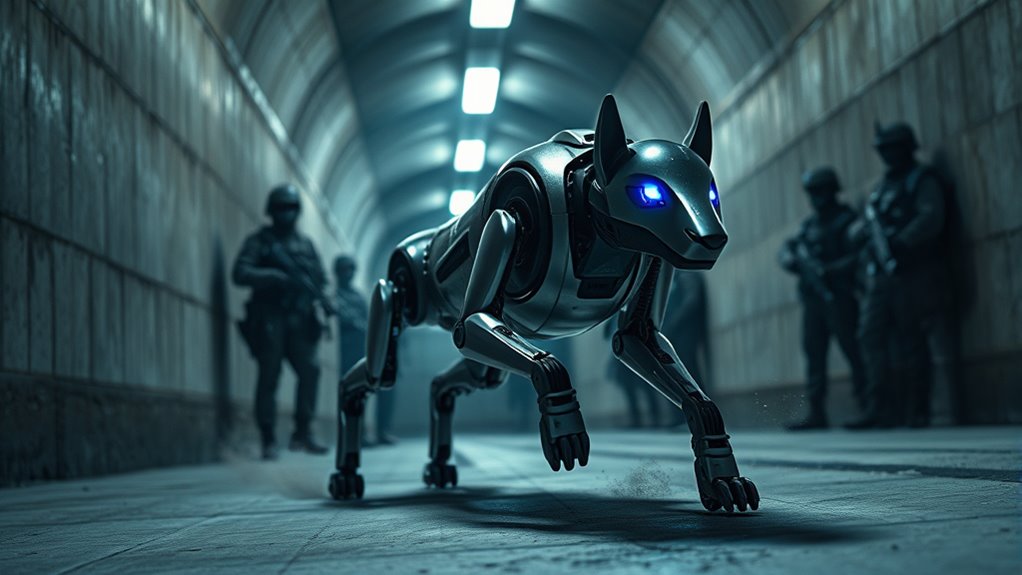
As military forces prepare for potential subterranean conflicts, they increasingly rely on cutting-edge technology, particularly robot dogs and unmanned ground vehicles.
Robot dogs excel in maneuvering through underground environments, minimizing risks for human soldiers. During drills, Q-UGVs support intelligence gathering and combat tasks, carrying explosives and tools for dangerous missions. They provide real-time data to assess tunnel systems, ensuring safety before troops enter.
Robot dogs and Q-UGVs enhance safety and efficiency in underground operations, gathering intelligence and assessing tunnel systems before troop deployment.
Training facilities simulate underground conditions, offering a safe environment for realistic scenarios. These robust and portable structures adapt easily to various training needs.
Additionally, drones complement ground robots, enhancing reconnaissance capabilities. Together, this technology fosters effective strategies and coordination, equipping forces with the tools needed for complex tunnel warfare operations.
Operational Objectives of the Exercises
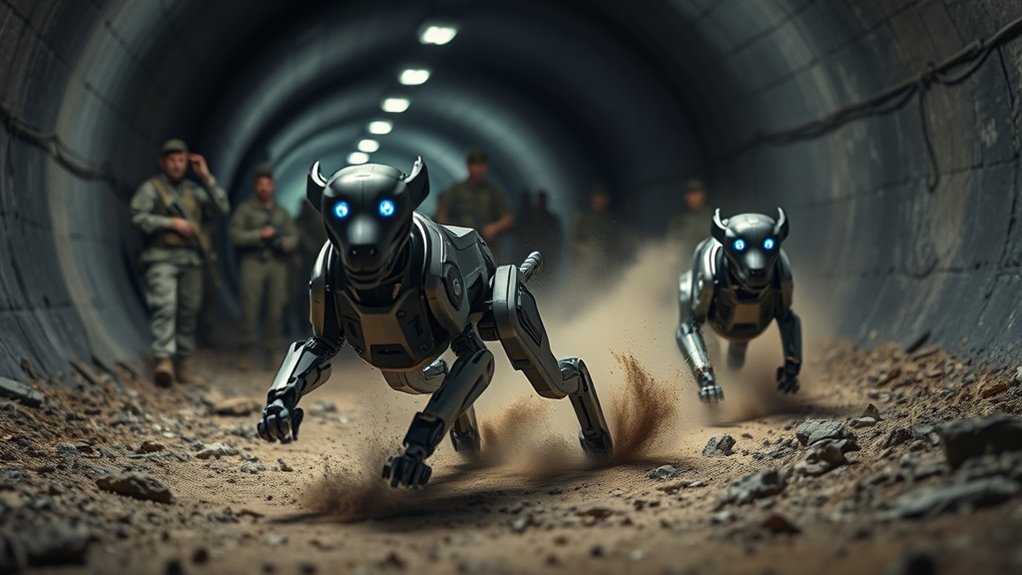
To effectively prepare for subterranean warfare, the exercises aimed to enhance joint capabilities, tactical proficiency, situational awareness, interoperability, and operational safety among participating forces.
Over four days in Paju, Gyeonggi province, more than 370 U.S. and South Korean soldiers trained to counter North Korea’s extensive underground infrastructure.
Using micro drones, you gathered real-time intelligence, detecting enemy positions and tunnel openings. Troops practiced blasting and sealing tunnels while deploying robot dogs to search facilities and safely detonate explosives.
Working together, you improved combat cooperation and established a unified command to address operational challenges. By integrating robotic systems, you reduced risks in high-risk environments, enhancing overall battlefield efficiency and safety during these critical drills.
Strategic Significance of North Korean Tunnels
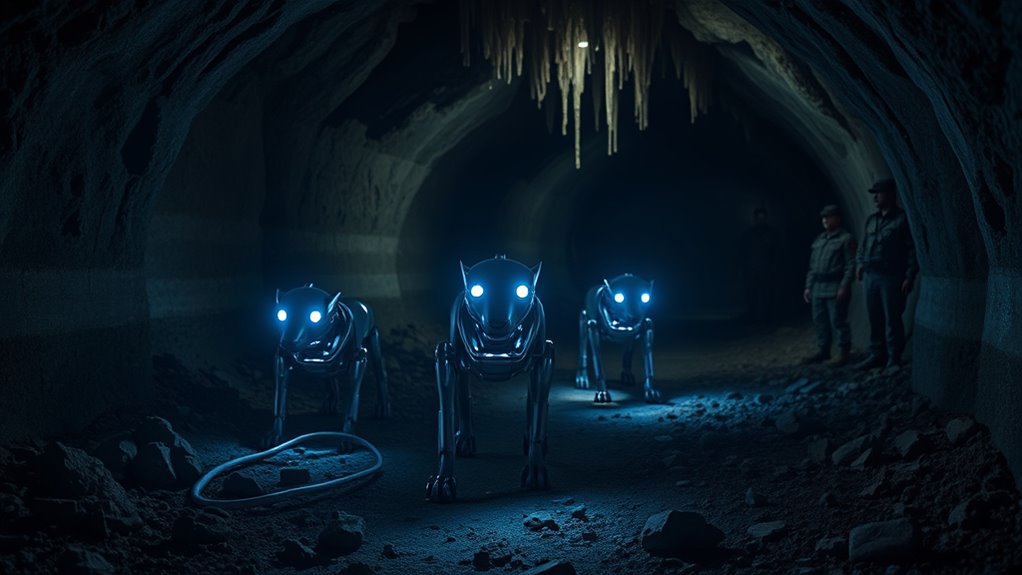
The strategic significance of North Korean tunnels becomes clear when considering their ability to bypass conventional defenses and facilitate rapid troop movement. Since their construction began in 1971, these tunnels have been an essential asset, allowing up to 2,000 troops to move per hour beneath South Korean fortifications.
Designed to create a second frontline, they disrupt enemy logistics and complicate military operations. Each discovered tunnel, reinforced with concrete and equipped with electricity, enables North Korea to maintain tactical flexibility and exploit underground advantages.
This network not only poses a direct threat to South Korean defenses but also highlights the potential for larger-scale military strategies unseen in other global contexts. Understanding these tunnels is imperative for evaluating regional security dynamics.
Integration of Robotics in Modern Warfare

While military strategies evolve, the integration of robotics into modern warfare has become increasingly crucial. You’ll find various types of military robots, including autonomous drones and four-legged robotic dogs, enhancing operational efficiency on the battlefield.
With AI integration, these robots can navigate challenging terrains and analyze their surroundings, performing complex tasks autonomously. They offer real-time decision-making and target recognition, allowing for quicker responses to threats.
Equipped with surveillance capabilities, they gather essential intelligence without risking human lives. The tactical possibilities are vast, from deploying explosives to sealing tunnels to real-time data analysis for predicting enemy movements.
Robotic systems revolutionize intelligence gathering, minimizing risks while expanding tactical options for modern military operations.
As you see, robotics fundamentally alters how military operations are conducted, paving the way for innovative strategies and enhanced safety.
Future Implications for Military Operations

As military operations evolve, the future implications of integrating robot dogs into combat scenarios become increasingly significant.
These advanced machines, equipped with cutting-edge sensors, enhance real-time monitoring and navigation in complex environments like tunnels. Their potential for weaponization raises critical questions about the changing landscape of traditional warfare.
With their adaptability for roles ranging from surveillance to explosives deployment, robot dogs provide tactical flexibility in diverse combat situations.
Additionally, joint exercises between nations highlight the importance of international cooperation in developing these technologies.
However, the ethical considerations surrounding autonomous decision-making in warfare warrant careful scrutiny, as we navigate the challenges and responsibilities that come with such advancements in military robotics.
Enhancing Battlefield Safety With Technology
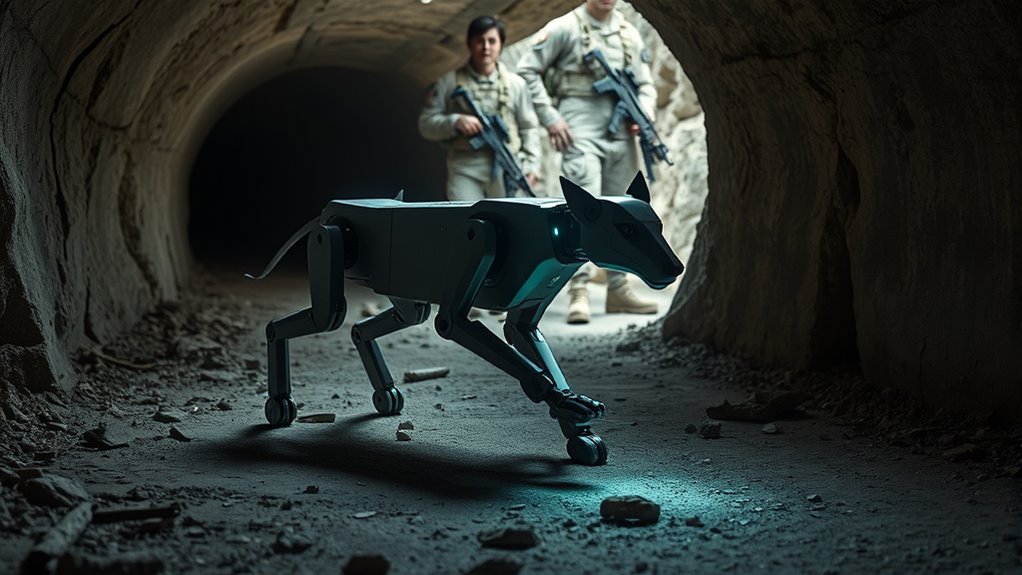
Advancements in technology are transforming battlefield safety, enabling soldiers to operate with greater confidence and reduced risk.
Helmet-mounted radar systems give you enhanced situational awareness, allowing you to detect movements behind walls. Tactical augmented displays keep vital information, like maps and targeting data, in your line of sight.
Wearable sensors improve mobility and comfort, while lightweight protective gear guarantees you stay safe without being weighed down.
Robotics, like robotic dogs, can navigate tunnels, minimizing human risk. Unmanned systems for reconnaissance protect you from hazards, and autonomous vehicles streamline supply operations, enhancing safety.
Advanced sensors and wrist-mounted displays provide real-time intelligence, making sure you’re always informed. Additionally, the use of energy-efficient systems can reduce operational costs in military operations, further supporting sustainable practices.
Together, these innovations create a safer battlefield environment for you and your team.
Collaborative Efforts Between the US and South Korea
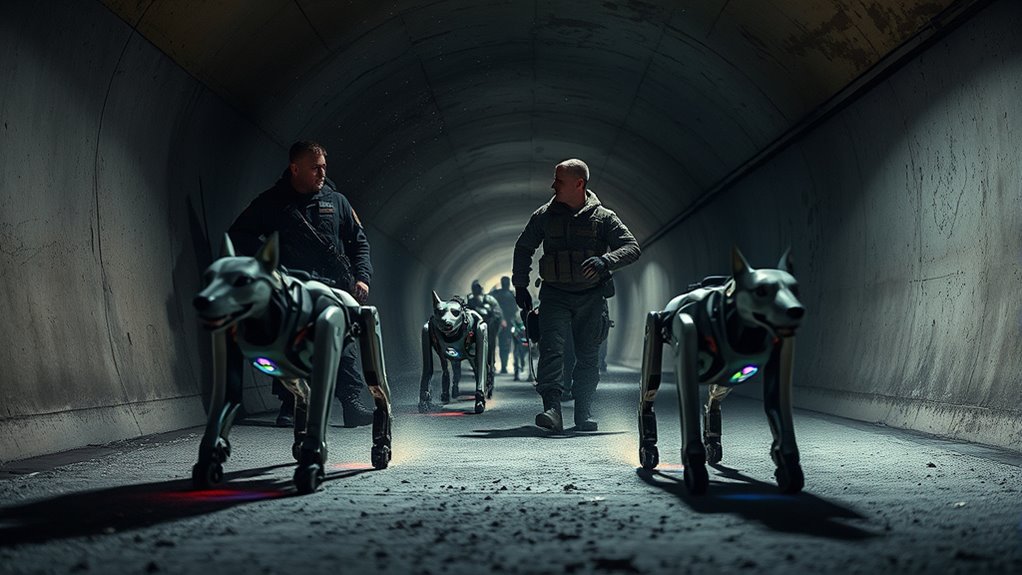
The U.S.-South Korea alliance, established in the aftermath of the Korean War, stands as an essential pillar for regional stability and security in the Indo-Pacific. This partnership, formalized in 1953 through the Mutual Defense Treaty, focuses on promoting peace and defending against external threats.
You’ll find that regular meetings, like the Security Consultative Meeting, strengthen cooperation and deepen defense collaboration. Joint military exercises, such as Freedom Shield, enhance readiness and interoperability, simulating scenarios against North Korea’s tunnel networks.
Together, the U.S. and South Korea modernize their militaries, integrating advanced technologies and improving supply chain resilience. By conducting joint drills, they prepare for potential threats, ensuring effective responses to complex security challenges in Northeast Asia.
The Role of Drones and Robot Dogs in Combat Scenarios
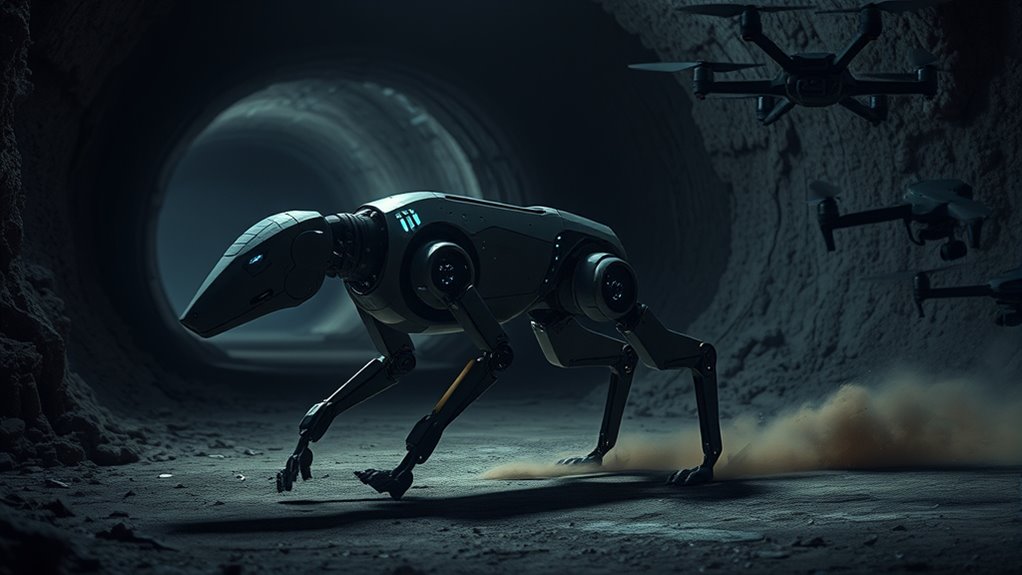
In modern combat scenarios, the integration of drones and robot dogs has transformed battlefield operations, enhancing both efficiency and safety.
Drones play a vital role in surveillance, offering real-time data and improving situational awareness. Their long-range capabilities force enemies into defensive positions, while their adaptability allows for effective operation in various terrains, including tunnels.
Robot dogs further reduce human risk in hazardous environments. They can execute tasks like carrying explosives and gathering intelligence, ensuring safer operations before troops engage.
Together, drones and robot dogs streamline combat strategies, providing tactical flexibility and cost-effectiveness. As technology advances, their roles in warfare will likely expand, making them indispensable assets on future battlefields.
Frequently Asked Questions
How Do Robot Dogs Communicate With Human Operators During Drills?
Robot dogs communicate with you through secure, real-time data links, ensuring you stay connected even in challenging environments.
They transmit live video feeds, allowing you to monitor their actions and provide immediate feedback. Their advanced sensors gather critical information, which they relay back to you for tactical decision-making.
Some robot dogs can even operate autonomously, making decisions based on pre-programmed protocols, all while maintaining communication with you throughout the mission.
What Specific Features Make Robot Dogs Suitable for Tunnel Warfare?
Did you know that robot dogs can navigate tunnel systems with up to 90% efficiency? Their terrain adaptability allows them to traverse narrow tunnels and uneven surfaces effortlessly.
Equipped with advanced sensors, they gather real-time data, providing essential intelligence without risking human lives. Their autonomous capabilities reduce the need for intervention, while stealth operations enhance reconnaissance.
Plus, their ability to carry tools and explosives makes them versatile assets in high-risk situations.
Are There Ethical Concerns Regarding the Use of Robotic Systems in Warfare?
Yes, there are significant ethical concerns regarding the use of robotic systems in warfare.
You might worry about their ability to distinguish between combatants and civilians, potentially increasing civilian casualties.
There’s also the question of accountability—if a robot causes harm, who’s responsible?
Additionally, delegating life-and-death decisions to machines raises serious issues about human dignity and moral agency.
As technology advances, these concerns will demand ongoing discussion and careful consideration.
How Are Robot Dogs Powered During Extended Operations?
Robot dogs during extended operations are powered mainly by batteries and portable power sources.
You can expect their missions to last several hours, but they might use solar panels or external power banks for longer tasks.
These robots operate autonomously, managing power without much human input.
Real-time monitoring guarantees they adapt their energy use, and optimized algorithms help reduce consumption, allowing them to efficiently perform various functions throughout their missions.
What Is the Cost of Deploying Robot Dogs in Military Exercises?
Ever wondered what it costs to release a robot dog in military exercises?
Well, deploying these high-tech canines isn’t cheap. You’re looking at initial prices ranging from $2,800 to over $165,000, depending on the model and features.
Add customization, training, maintenance, and logistical expenses, and the total hits a staggering sum.
While they enhance operational efficiency and reduce human risks, the upfront investment can be intimidating for any military budget.
Conclusion
To sum up, the integration of innovative technology like robot dogs into military maneuvers showcases a significant shift in combat capabilities. As the US and South Korea strengthen their strategic synergy, these drills not only enhance operational efficiency but also pave the way for safer, smarter warfare. With a focus on future-forward tactics, this partnership promises to tackle tunnel threats head-on, transforming traditional training into a tech-driven triumph that could redefine battlefield dynamics for years to come.
